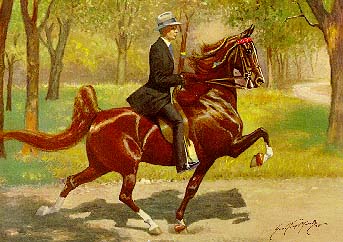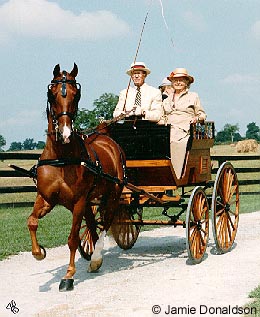

American Saddle Horse


Introduction: The American Saddle Horse is primarily a show-ring animal. Originally bred to be a stylish and comfortable plantation walker, it is now educated to give an extremely mannered performance under saddle, an exhibition unrivaled for power, elegance, and beauty. Flashing into the ring, the Saddle Horse is a breathtaking study in equine excitability held by the rider in perfect control. If you have any comments or suggestions, please click here. The painting above is labeled Wing Commander on the site where I got it; I believe he was a famous Saddlebred stallion.
Names: American Saddlebred,
Saddlebred, Saddler, American Saddle Horse, Saddle Horse. I even found
this called the American Saddlebred Horse! I may use any
short form on this page.
I should probably also mention that in some older books I
have found this breed called the Kentucky-Virginia Saddle Horse. I am
assuming that they are confusing this breed from a separate one that it
originated from--the Kentucky Saddler mentioned below--although I suppose it is
equally possible that the Kentucky Saddler faded into the American Saddlebred.
I suppose the one thing lacking to prove this latter case would be the complete
disappearance of the Kentucky Saddle Horse, and this I have not yet done enough
research to prove. (I should probably add that I also found a book using
the name Virginia Saddle Horse and referencing it to the American Saddle Horse.)
Origin: One of the earliest needs of the settlers was for an amiable, good-looking horse to carry them quickly about their business. They evolved a type known as the Kentucky Saddle Horse (also known as Kentucky Saddler), bred up from imports from England and other countries, which, after 1891, evolved into the American Saddle Horse.
Breeding: Other strains (besides Kentucky Saddler) have since been introduced, including Morgan and Standardbred, but Thoroughbred now predominates. The result is the most showy and elegant of animals. According to an older source, breeding areas and studs are mainly in Kentucky and Virginia, with many large and small private breeders. This is, of course, probably still true, although Saddlebreds are now quite common throughout the United States. The same source also said that the breed originated from crossing Canadian mares, of unknown descent and pedigree but imported by the first colonists, with Thoroughbred stallions, which would lead me to believe they may well be talking about the original Kentucky Saddler, more than the modern American Saddlebred (see the paragraph above concerning names of the breed).
Description: He is rounded and muscular, since his high-stepping action requires great strength and control. Sloping shoulders contribute to the smoothness of his movement. The pasterns of the Saddler's leg are unusually long, and it is these, flexing sharply at every step, that give this horse his exceptional style in moving.
Action: High. Vigorous, brisk action in all three gaits, especially in the trot which is high and active. (One source stated this trot is "almost competing with the Trotters themselves." I assume this is a reference to the Standardbred mentioned lower on that page, but if so it must be a statement to the age of the book that the Standardbred's gait has probably lengthened and the Saddlebred's heightened since that time.)
Body: Short, strong, and straight back, ending in a flattish croup. Neck held high, curved; high withers; well-placed shoulders.
Color: Saddle Horse colors run to brown, black, bay, or chestnut, often with a flash of white on the face and legs.
Head: Handsome; carried very high and rather proudly. Large expressive eyes.
Hooves: Good but not very large.
Legs: Well-developed, clean limbs with strong, marked tendons and joints and rather long, springy fetlocks.
Size: 15-15.3 hands. Averages close to 16 hands. An older source stated 15.1 to 16.1 hands.
Tail: Beautiful; set and carried high (formerly helped by surgery, as a rule; I'm not sure about more recent times).
Temperament: Lively temperament, good character.
Features: Smooth effortless ride.
American Saddle Horses are
trained as either three-gaited or five-gaited performers. Both types do
the walk, trot, and canter; the five-gaited animals have, besides these natural
gaits, two acquired ones--a slow gait and the rack (at least one source refers
to these as the amble and flying pace, or racing pace). In whatever step he
moves, the action of the Saddle Horse is alert, smooth, and showy, with
phenomenal elevation of the feet. His canter, for example, is not the
free, ground-covering motion of other horses, but an extremely
"collected," or reined-in rocking action. The rack is a
spectacular four-beat gait in which the horse bursts ahead at speeds sometimes
approaching 30 miles an hour, but with the same precisely-cadenced footwork and
high elevation of the feet displayed in all the other gaits.
To become a five-gaited Saddler, an individual of the breed
needs an aptitude for the two unnatural gaits. Due to the extra muscular
exertion that they require, he will develop into a somewhat more
powerful-looking animal than his three-gaited relative.
Very distinguished, elegant saddle horse of English
origin. Once the favoured remount of the American cavalry. Has
stamina; tough, easy going.
Uses: Once
used by families in the South of the United States as a riding and harness
horse. Not all members of the breed are shown under saddle. Some are
trained to perform in fine harness, drawing a four-wheeled show wagon at the
walk and park trot.
The Saddler is not such a rarified creature as all the
expense and attention it receives suggest. Strong, quick to learn, and
basically good-natured, a Saddler in retirement from the ring, or one of
insufficient promise to be trained for show, makes a spirited mount for pleasure
riding. Some have excelled as hunters.
Accomplishments: When
a Saddle Horse performs with spirit, precision, and instant response, it due
first to the training he has received, and second to the quality of his
ancestors.
For a Saddler of such championship promise as the old greats, the price may go
to $70,000 or more.
Curiosities: The
beauty of the Saddle Horse show performer is partly inborn, partly
man-made. His coat has been brought to a lustrous sheen by hours of
brushing. His long silky tail and its plume-like set are also the result
of cosmetic attention, including hand-combing and perhaps the addition of false
hair. Also, the muscle that normally acts to lower the tail has been
surgically nicked, causing the base of the tail to rise in a spirited
arch. (This applies to the five-gaited horses; three-gaited Saddlers are
customarily shown with natural tails shaved along the top of the bone.)
Specially-weighted shoes are one of the assists the Saddle Horse has in
achieving perfectly balanced action.
The
feet are large and weighted with heavy shoes to achieve the vertically elevated
movement of the legs. The tail vertebrae are broken surgically to produce
a fixed, poised look once the tail heals.
Profiles: Tom Hal - a Canadian pacer, foaled in 1806; one of the first great horses to contribute to the Saddlebred breed; in his 41-year-lifetime, he founded a strain of Saddlers of extraordinary quality. Denmark - a Thoroughbred, born in 1839, the foundation sire of the Saddlebred breed; a racing great; mated with a Saddler called the "Stevenson mare" in 1851, produced a son who later surpassed him in greatness, Gaines Denmark. Gaines Denmark - Denmark's son, most Saddlebreds descend from him; he won fame as a Civil War charger. Bourbon King - a top performer in the 20th century; from the family of Tom Hal. Wing Commander - supreme among five-gaited Saddlers between 1948 and 1954.
Conclusion: